StoreSEO helps configure SEO for blog posts and pages on Shopify so that they have more online visibility among your potential customers. StoreSEO makes sure everything is in order by showing an SEO score and all the issues that need to be fixed in order to bring a good SEO score for your Shopify blog post. This documentation will cover all these.
Before you start, make sure you have added a blog post and installed StoreSEO app on your Shopify store. Then, follow these step-by-step guidelines to find out how to optimize the blog post with StoreSEO.
Step 1: Navigate To StoreSEO Blog Post Optimization #
Log in to your Shopify store. Then, from the search bar on the top or the ‘Apps’ option in the left sidebar, search for the StoreSEO app and click on it. From the StoreSEO dashboard, go to the ‘Optimize SEO’ tab. Now click on the ‘Blog Posts’ option.
Once your blog posts are synced properly, you will see your blog post list on this page. Choose the one you want to optimize, and click on the ‘Fix issue’ button.
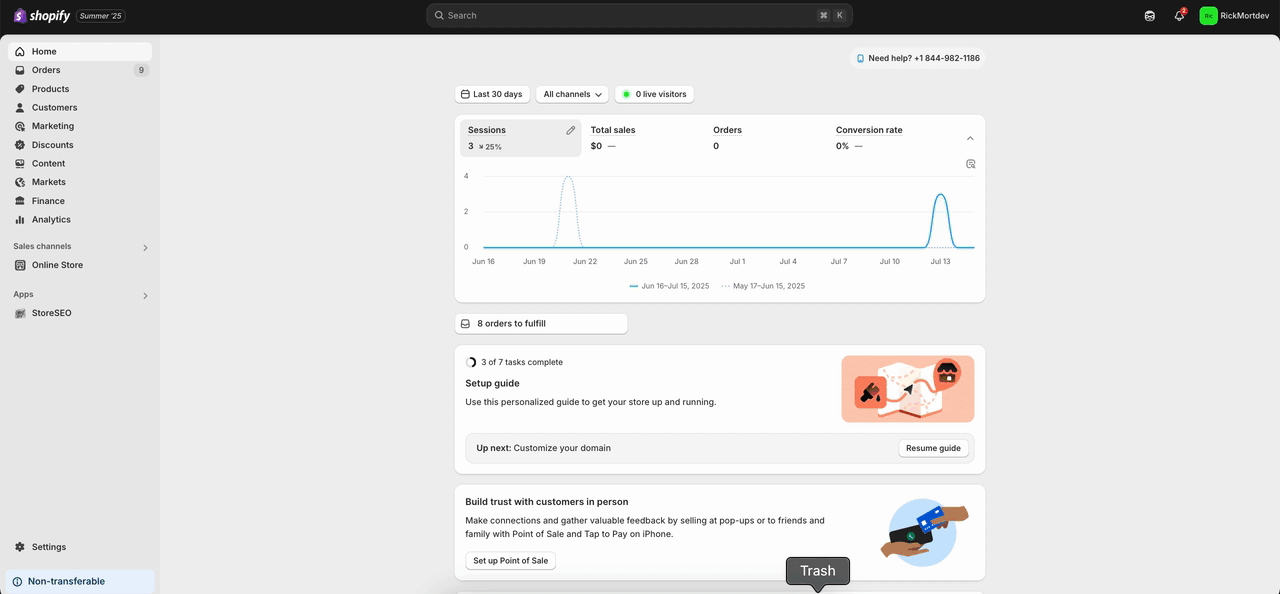
Step 2: Optimize Your Blog Post On Shopify #
Now, it is time to optimize SEO for your Shopify blog post. As you can see in the image below, the SEO details of your selected blog are shown by StoreSEO. From the right side panel, you will also find Basic SEO Analysis and Detailed SEO Analysis to find the key factors that have to be addressed to improve the SEO Score.
Basic SEO Analysis #
Let us start with Basic SEO Analysis. Here, we have to ensure various criteria such as placing a unique focus keyword in the required places, maintaining an optimized length of the meta title and description and others. We will now show you how to do these one by one.
Focus keyword is unique #
First, you need to choose the proper focus keyword. This is crucial because the blog is indexed on search engines based on this keyword. To put it simply, your potential readers or audience will have a higher likelihood of finding your blog post if their search keyword and your selected focus keyword match.
Therefore, you need to be very careful and do proper keyword research when choosing the focus keyword. Here are a few things to consider:
Keyword relevance: Make sure the keyword is relevant to your blog topic, business, audience and niche. Suppose, you are selling leather formal shoes. Your focus keyword should be relevant to this product. Now, you select a high search volume keyword containing the term ‘leather bag’ or ‘formal shirt’. These keywords are outside your product niche. So although it might have a higher search volume, it will not be a relevant option.
Search volume: Keywords with higher search volume have more searches every month. If you select keywords with higher search volume, you are more likely to face more competition. The more specific keywords you use, the more precisely you can reach your target audience.
Now, if you choose a long focus keyword such as ‘Water Resistant Synthetic Leather Formal Shoes’, you have a unique keyword but there is less possibility for customers to use this entire keyword during a search. This is why it does not have a good search volume as shown in the image below.
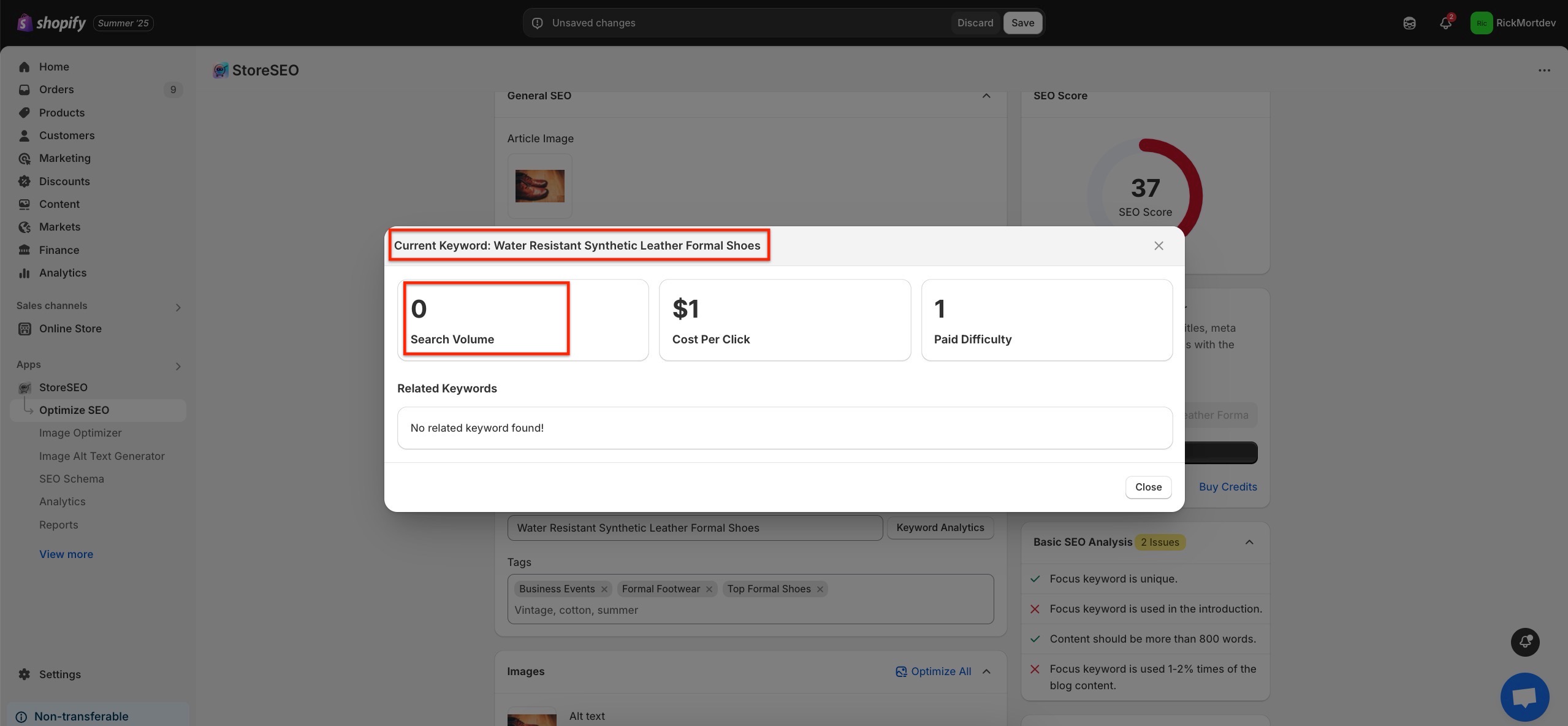
Now, if you choose a short focus keyword like ‘Leather Shoes’, you will find it has a high search volume as shown in the image below. However, such popular keywords have too much traffic and will be a lot harder to rank and reach out to your audience.
On the other hand, if you select the focus keyword ‘Synthetic Leather Shoes’, you have a good search volume (not too high) and there is a higher possibility to index without facing much competition. This is why this is the more appropriate focus keyword option in this particular case.
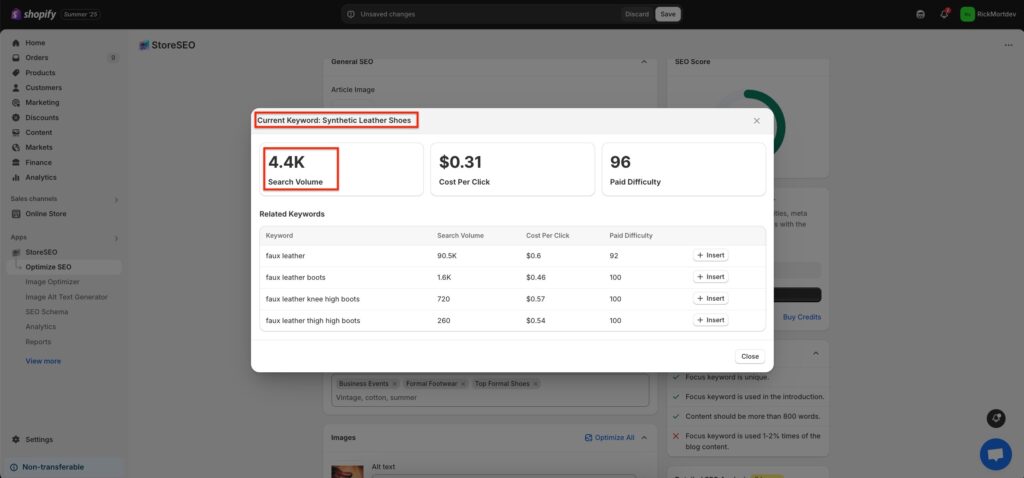
Cost per click: If you are running ads with particular keywords, the cost per click determines the approximate budget for the ad campaign. So, choosing keywords with a higher cost per click means you need to have a bigger campaign budget. Please note that it is an estimated value and you do not have to worry about it if you are not running any ads.
Paid difficulty: This represents the demand for keywords when used in paid ads. Higher paid difficulty indicates the keyword also has more competition in organic search. So, it is an important metric during keyword research.
Related keywords: Remember to check the related keywords for a particular keyword. These related keywords will give you additional keyword suggestions. So, you might come across a better focus keyword option. Make sure the related keywords suit your product, business, audience and niche.
Back to blog post optimization on StoreSEO, place your preferred keyword in the ‘Focus Keyword’ field. Click on the ‘Keyword Analytics’ button to instantly get the Search Volume, Cost Per Click, Paid Difficulty and related keywords for your keyword.
Here, we have selected ‘Synthetic Leather Shoes’ as the focus keyword. It is recommended that different focus keywords be used for different blog posts. Please choose a keyword according to your business and the blog topic. Do keyword research for Shopify for this.
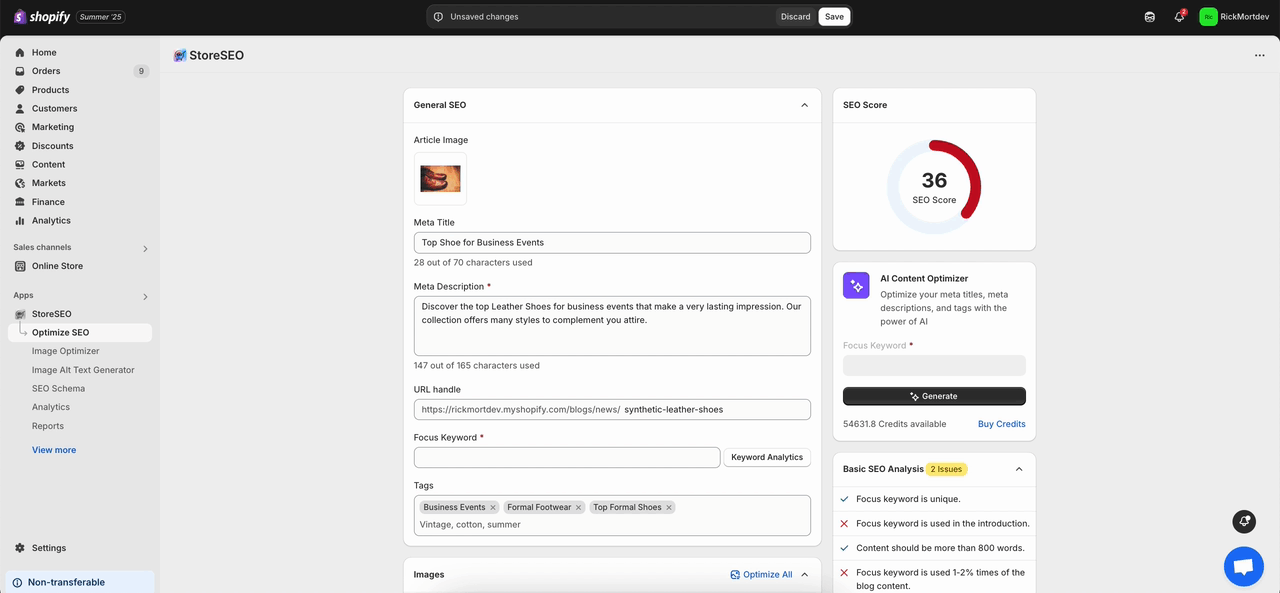
Focus keyword is used in the introduction #
Next, make sure the focus keyword is used in the introduction of the blog post. To edit your blog post, navigate to Sales Channels in the left side panel of your Shopify dashboard. Then, select ‘Online Store’ and click on the ‘Blog posts’ option. Select the blog you want to edit. Make sure to place the focus keyword in the introduction. As you can see in the image below, our blog’s introduction contains ‘Synthetic Leather Shoes’ or our selected focus keyword.
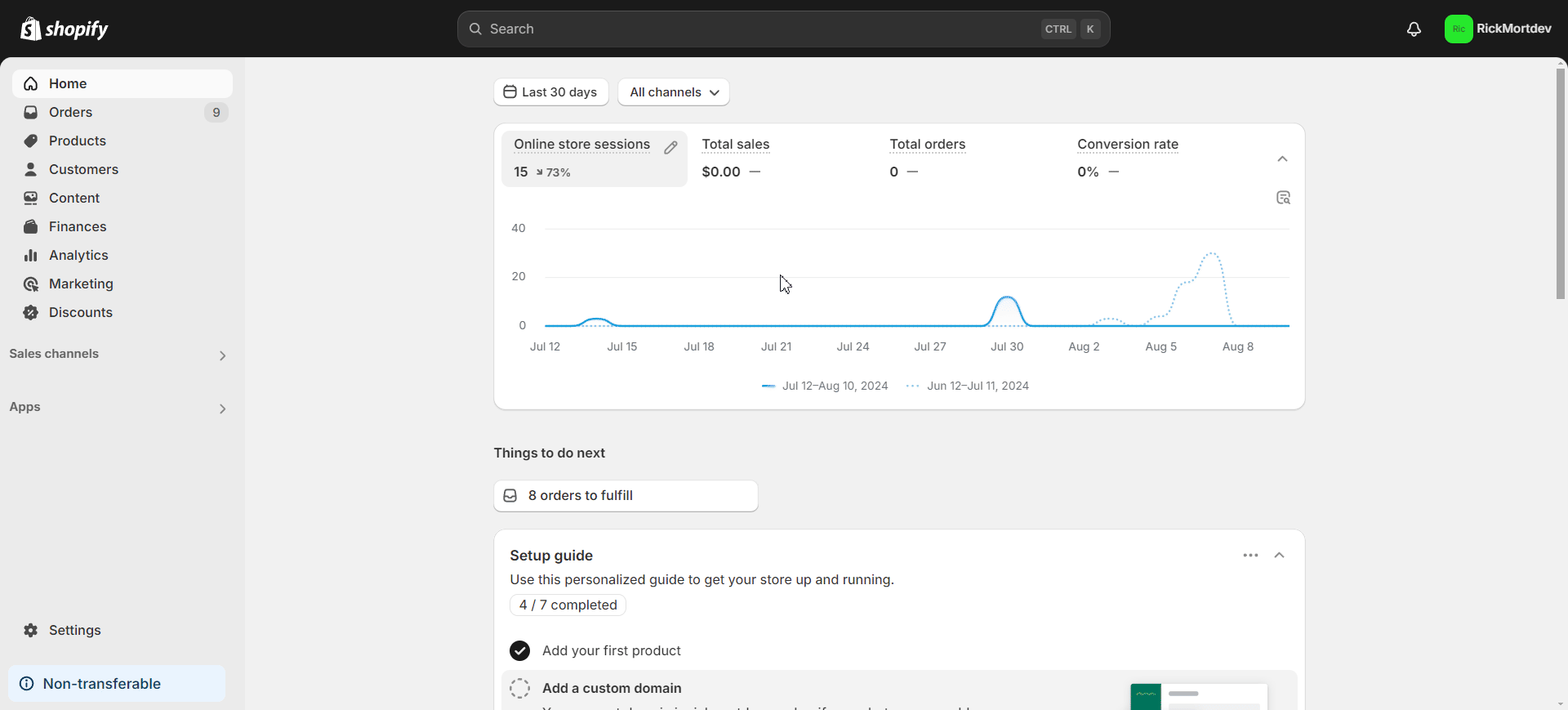
Content should be more than 800 words #
Include more than 800 words in the blog content to further optimize the SEO score. Make sure that your blog content contains more than 800 words while maintaining relevance and meaningfulness as shown in the image below.
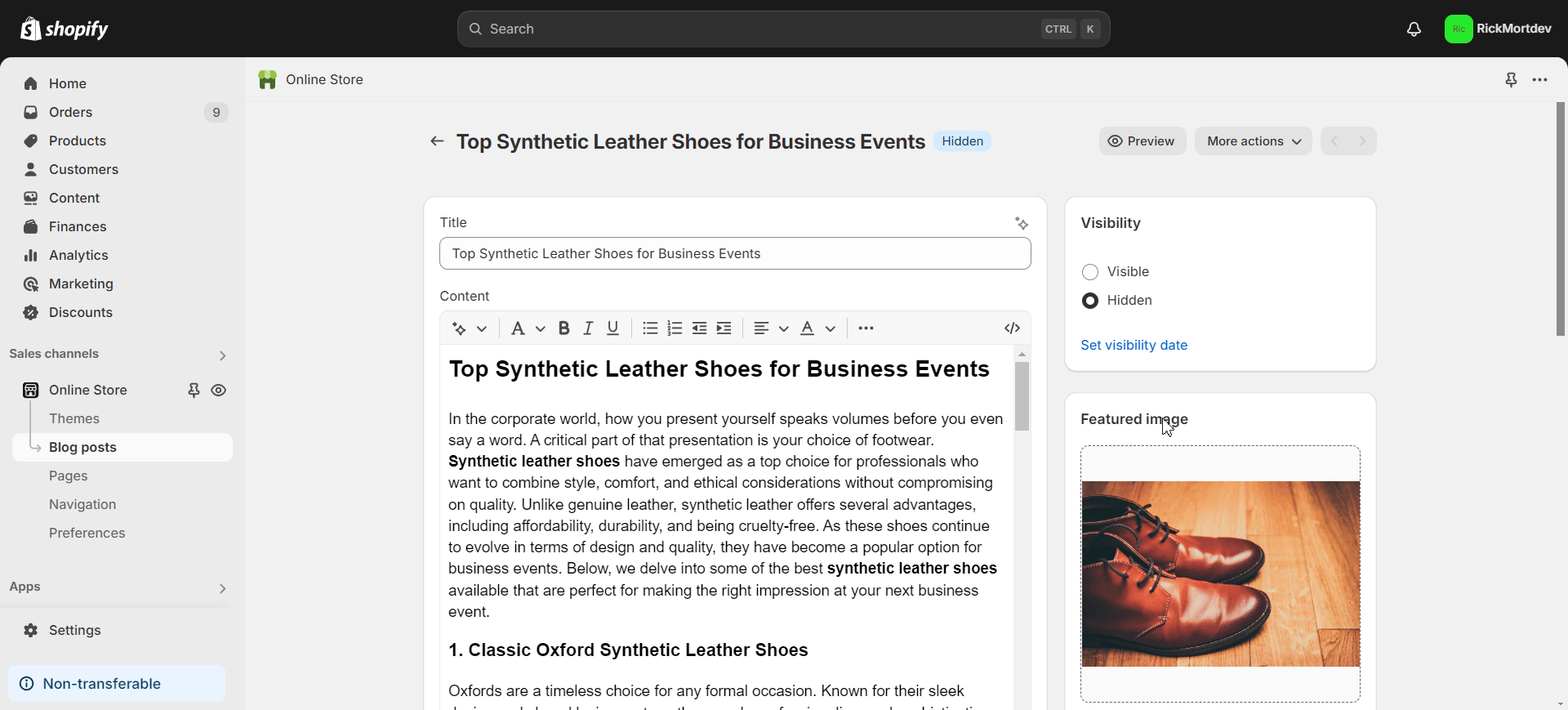
Focus keyword is used 1-2% times of the blog content #
Your focus keyword should be used 1-2% times of the blog content. But avoid keyword stuffing or placing the keyword forcefully or unnaturally. As you can see in the image below, we have placed our selected focus keyword to maintain the ideal frequency mentioned above.
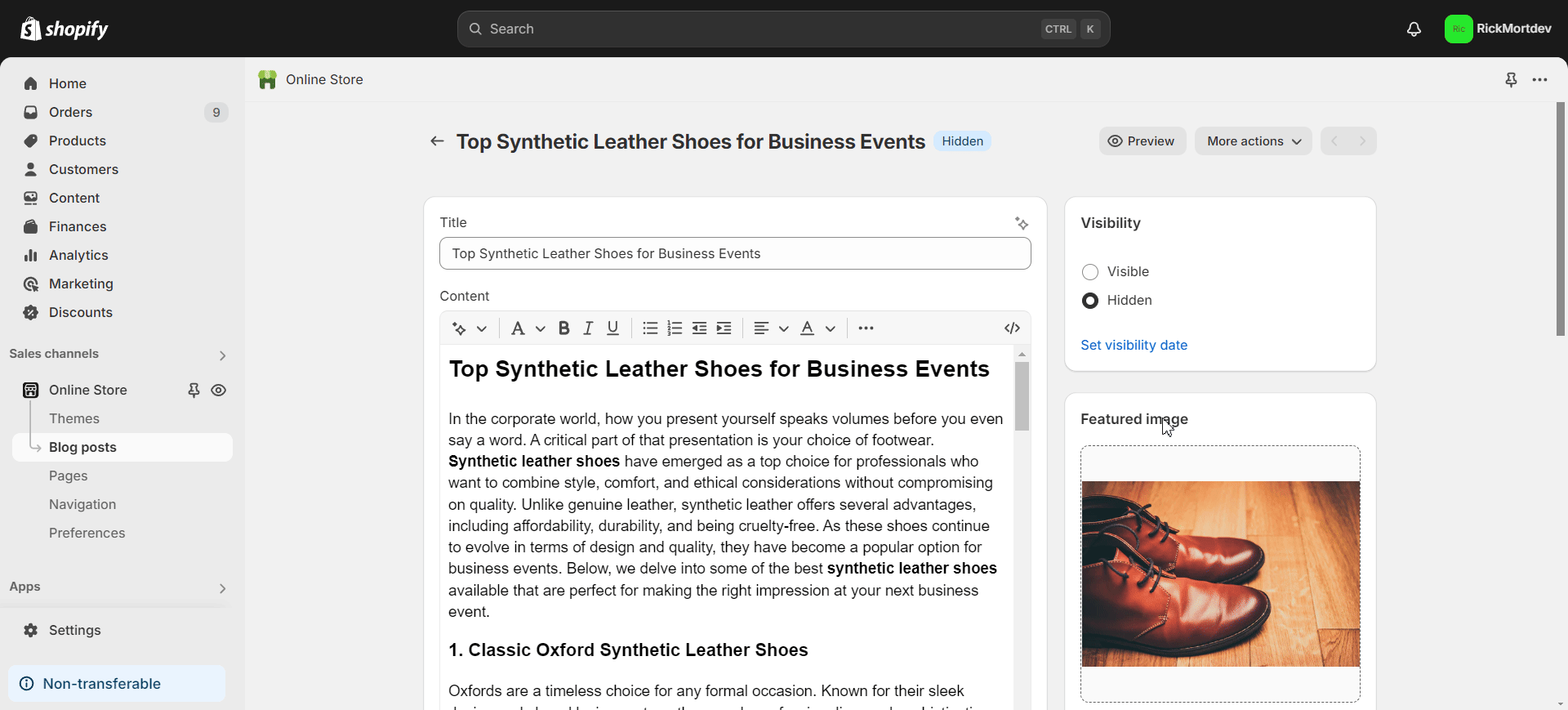
Detailed SEO Analysis #
We will now proceed to the Detailed SEO Analysis. For this, we have to make sure to place the focus keyword in the image alt text, subheadings, meta description and URL and meet a few other requirements. Let us show you how to do all these.
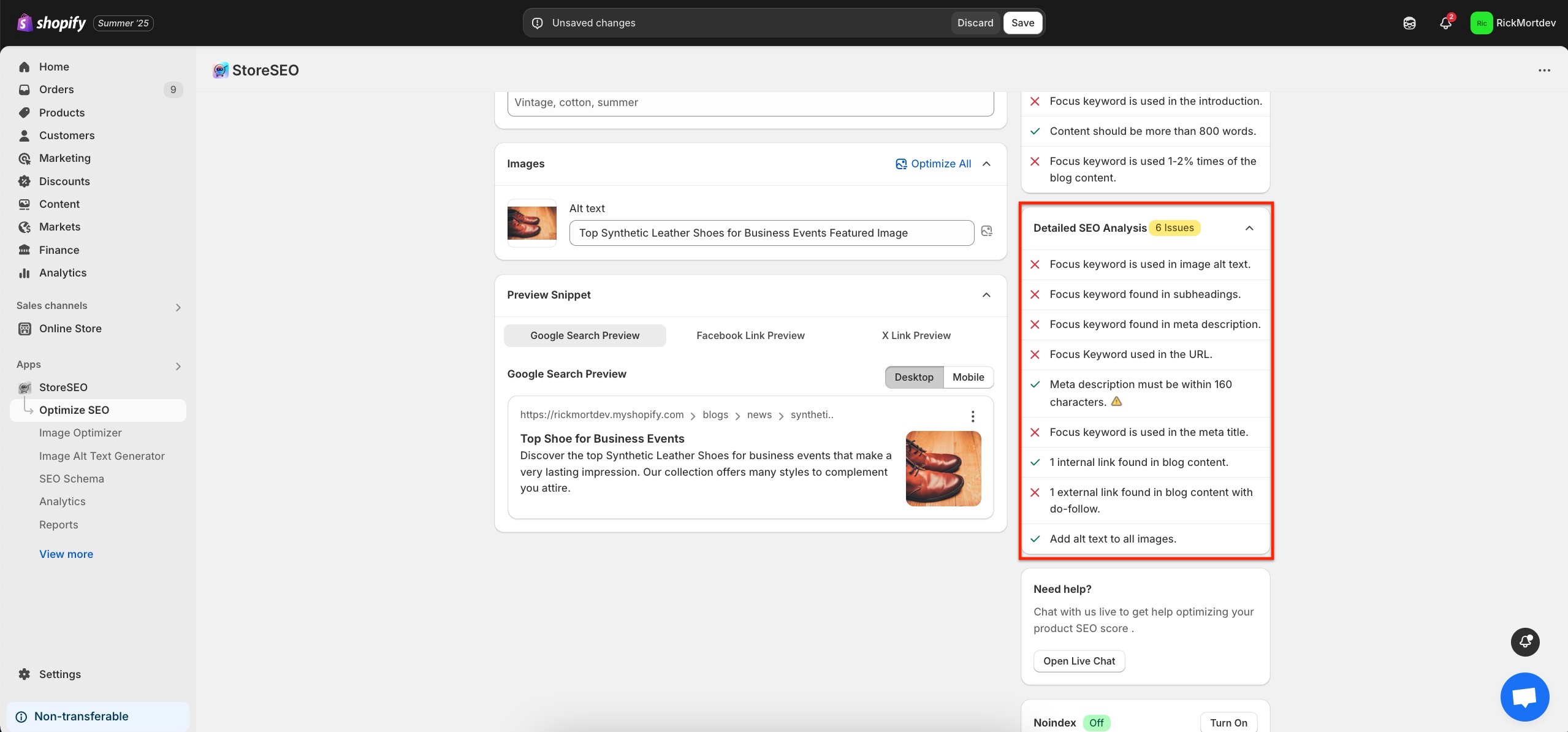
Focus keyword is used in image alt text #
Make sure the focus keyword is used when adding the image alt text of the blog’s featured image. For this, navigate to StoreSEO blog post optimization for your desired blog. Under the ‘Images’ section, you will find the ‘Alt text’ field. Place your desired alt text containing the focus keyword in this field.
As you can see in the image below, the Alt text field ‘Top Synthetic Leather Shoes for Business Events Blog Featured Image’ contains our selected focus keyword (marked bold).
Focus keyword found in subheadings #
Make sure your blog’s subheadings contain the focus keyword. You can add this to your subheading when editing your blog from the Shopify dashboard as discussed previously. As you can see in the image below, our subheading ‘Classic Oxford Synthetic Leather Shoes’ contains our selected focus keyword (marked bold).
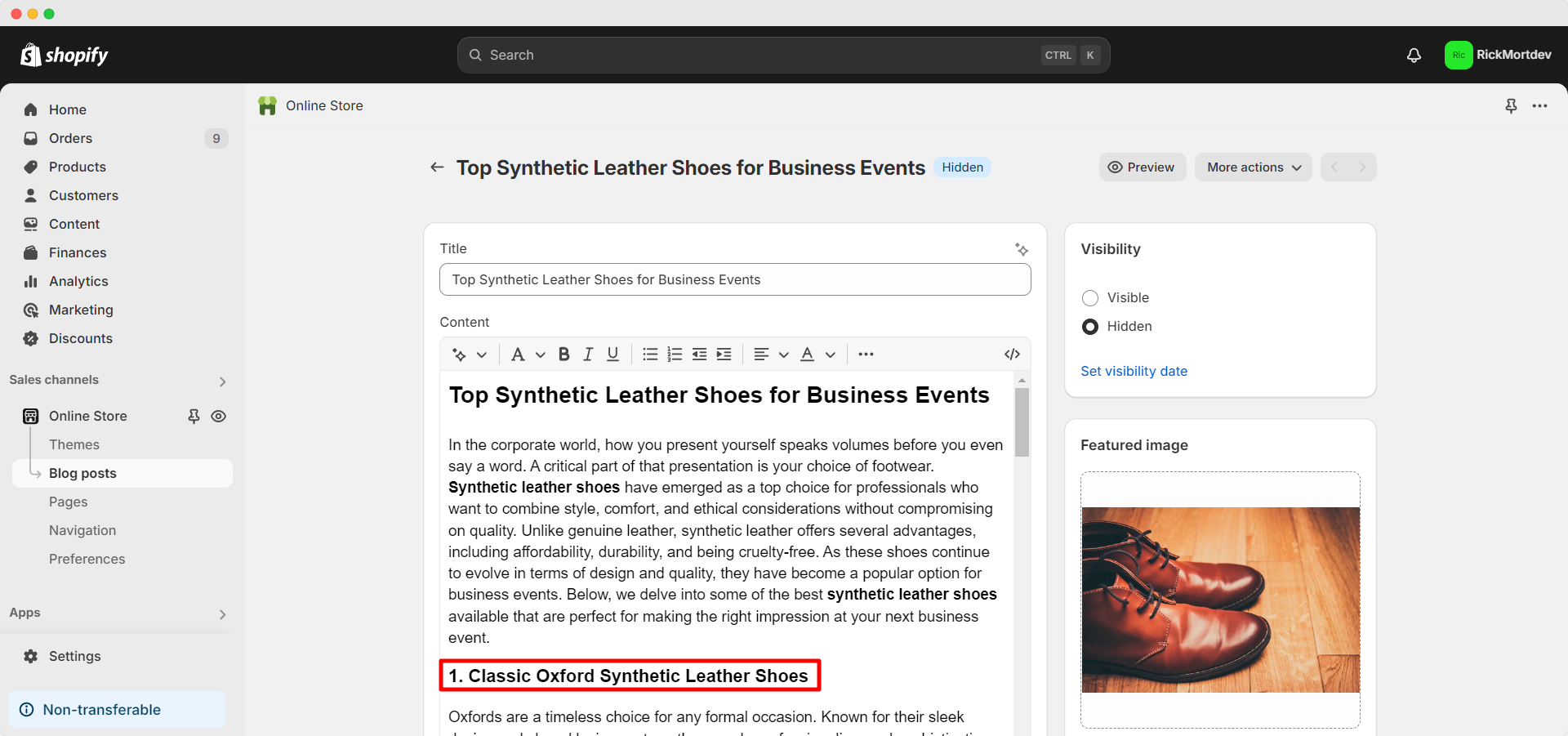
Focus keyword found in meta description #
Your meta description should contain your selected focus keyword. From StoreSEO blog post optimization, you can add the focus keyword in the meta description field. Our meta description is the following:
Discover the top Synthetic Leather Shoes for business events that make a lasting impression. Our collection offers a variety of styles to complement your attire.
So, it contains our selected focus keyword (marked bold)
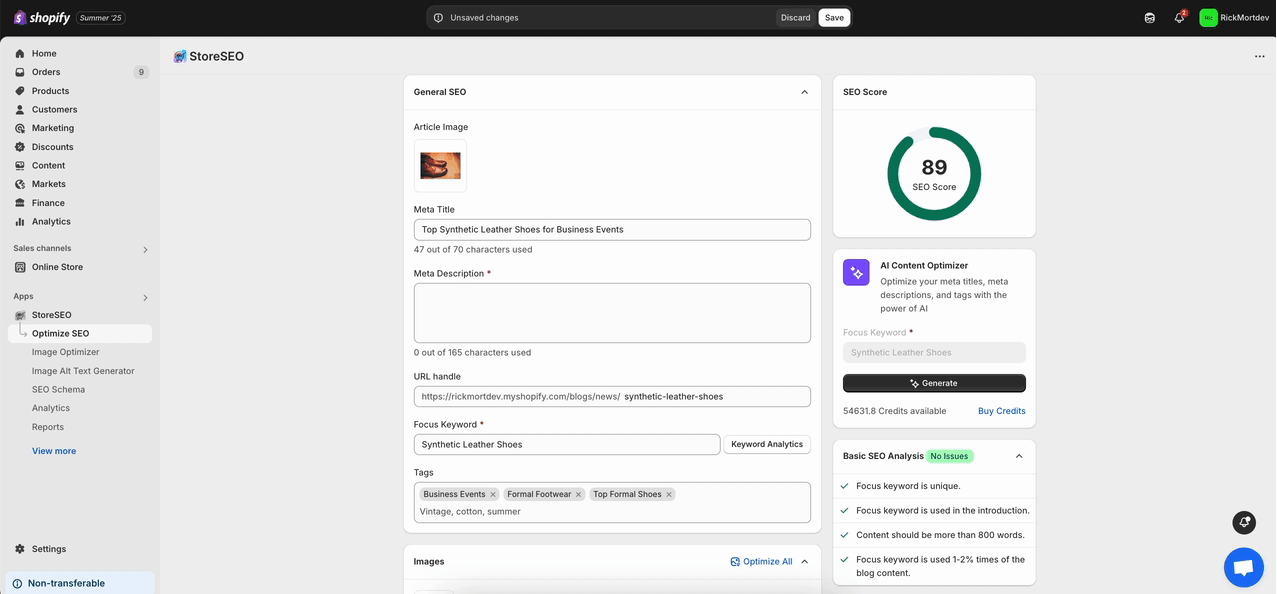
Focus keyword used in the URL #
Make sure that the Shopify blog post URL contains the focus keyword. You can edit the URL from under the ‘URL handle’ field when optimizing your blog post with StoreSEO. As you can see, the URL field contains ‘Synthetic Leather Shoes’ or our selected focus keyword.
Note: If your blog post has already been indexed and you want to change its URL, it is recommended to create a URL redirection.
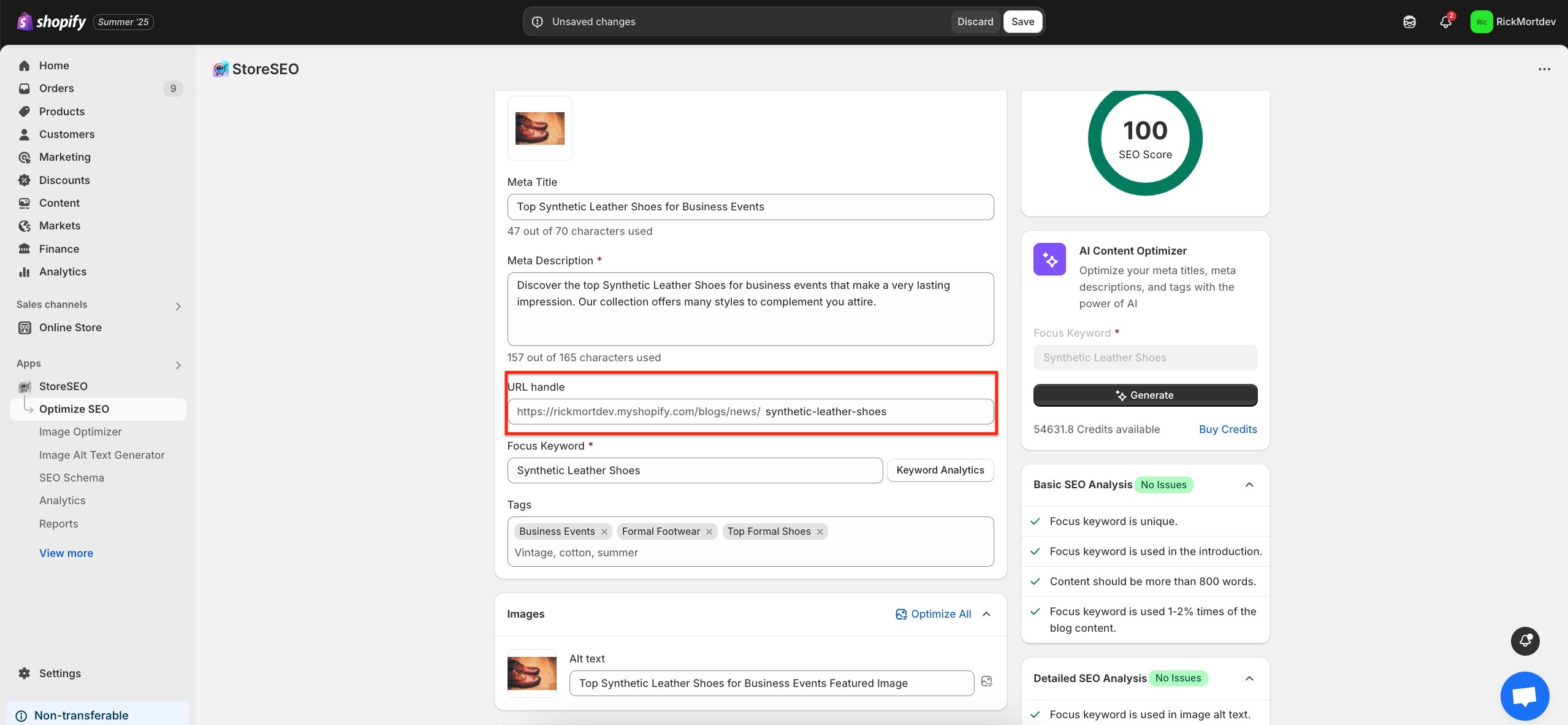
Meta description must be within 160 characters #
Your blog post’s meta description should be ideally within 160 characters. As you can see in the image below, our meta description is 159 characters long, which meets this requirement.
Focus keyword is used in the meta title #
Make sure your meta title contains your selected focus keyword. As you can see in the image below, our meta title is the following:
Top Synthetic Leather Shoes for Any Business Events or Formal Settings
So, the meta title contains our selected focus keyword (marked bold).
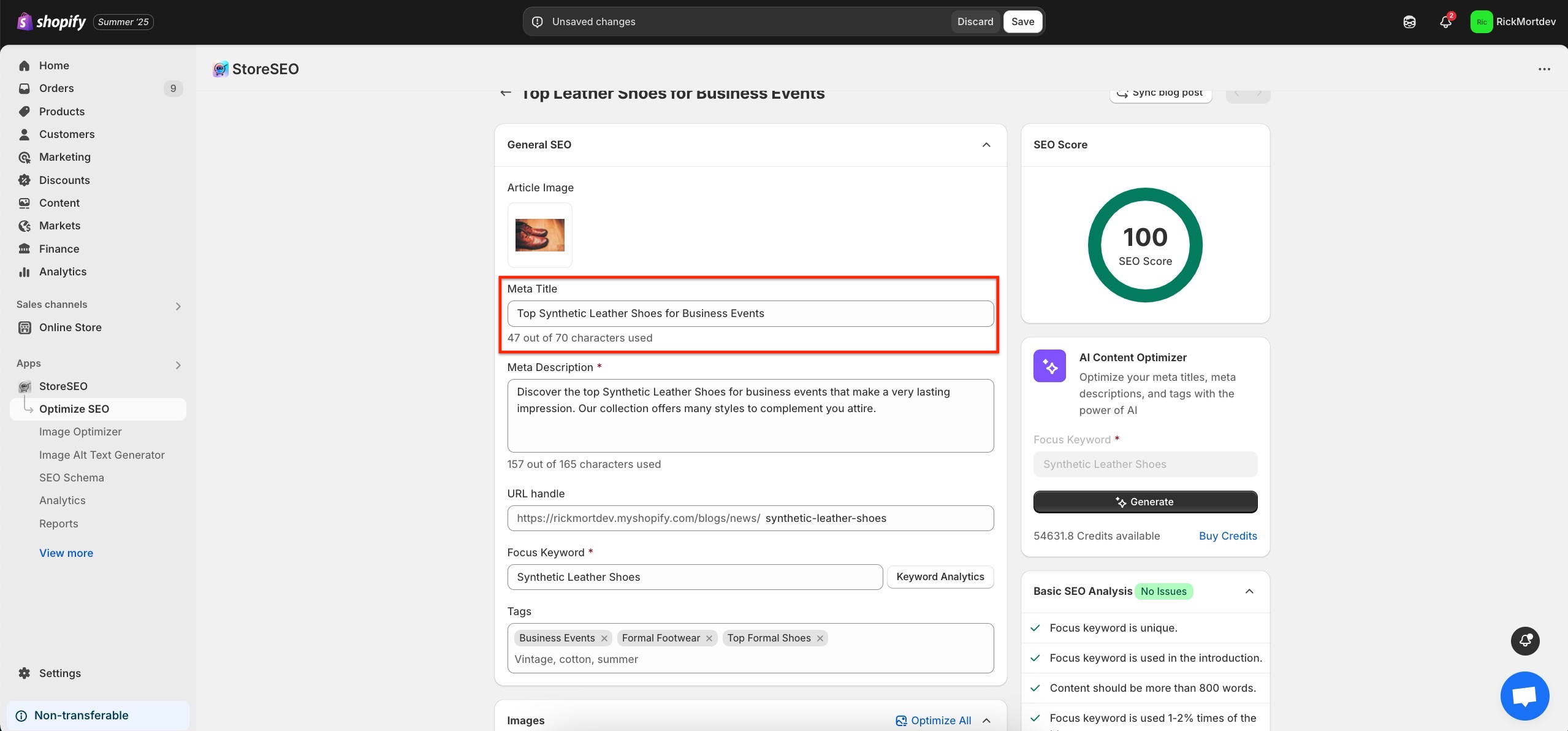
1 internal link found in blog content #
Your blog content should contain 1 internal link. Internal link means linking to another blog, page or product of your Shopify store. To add this, proceed to edit your blog post from the Shopify dashboard as described previously. Select the words you want to set as anchor text and click on the three-dot option in the ‘Content’ section. Next, select the ‘Insert link’ option. Enter the internal link in the designated field. You also get to choose if the link will open in the same or new window upon clicking. You can set a link title as well. Click on the ‘Insert link’ button when you are done.
Try to link to a page or blog post of your store relevant to the blog topic or the product or service discussed in your blog. As you can see in the image below, we have internally linked our blog to our FAQs page.
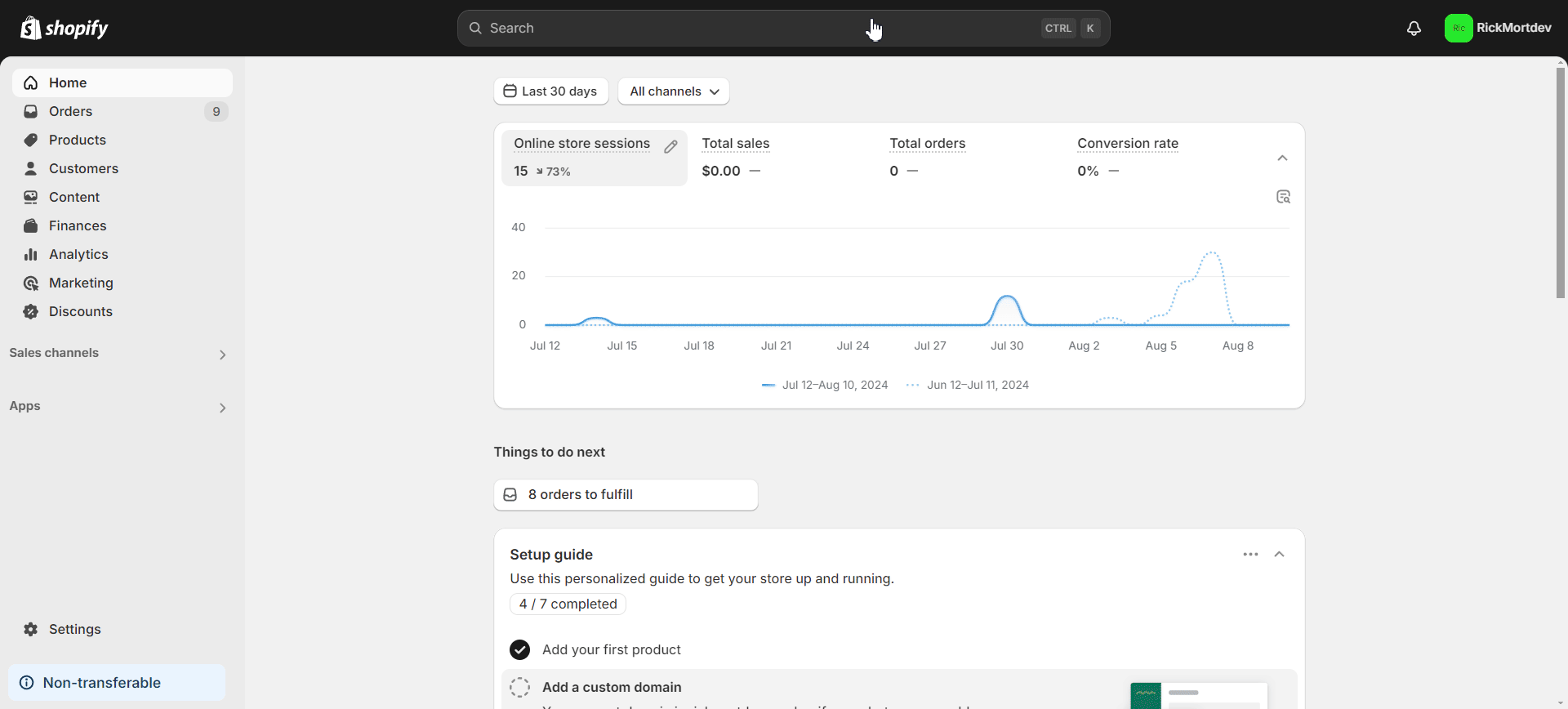
1 external link found in blog content with do-follow #
Keep one external link in the blog content with do-follow. External link means linking to external pages outside your Shopify store. Include it when editing your blog post as shown in the previous point.
Try to link to a high authority external link of a blog post or page. Also, the external link should be relevant to the blog topic or the product or service discussed in your blog. As you can see in the image below, we have included 1 external link in our blog content.
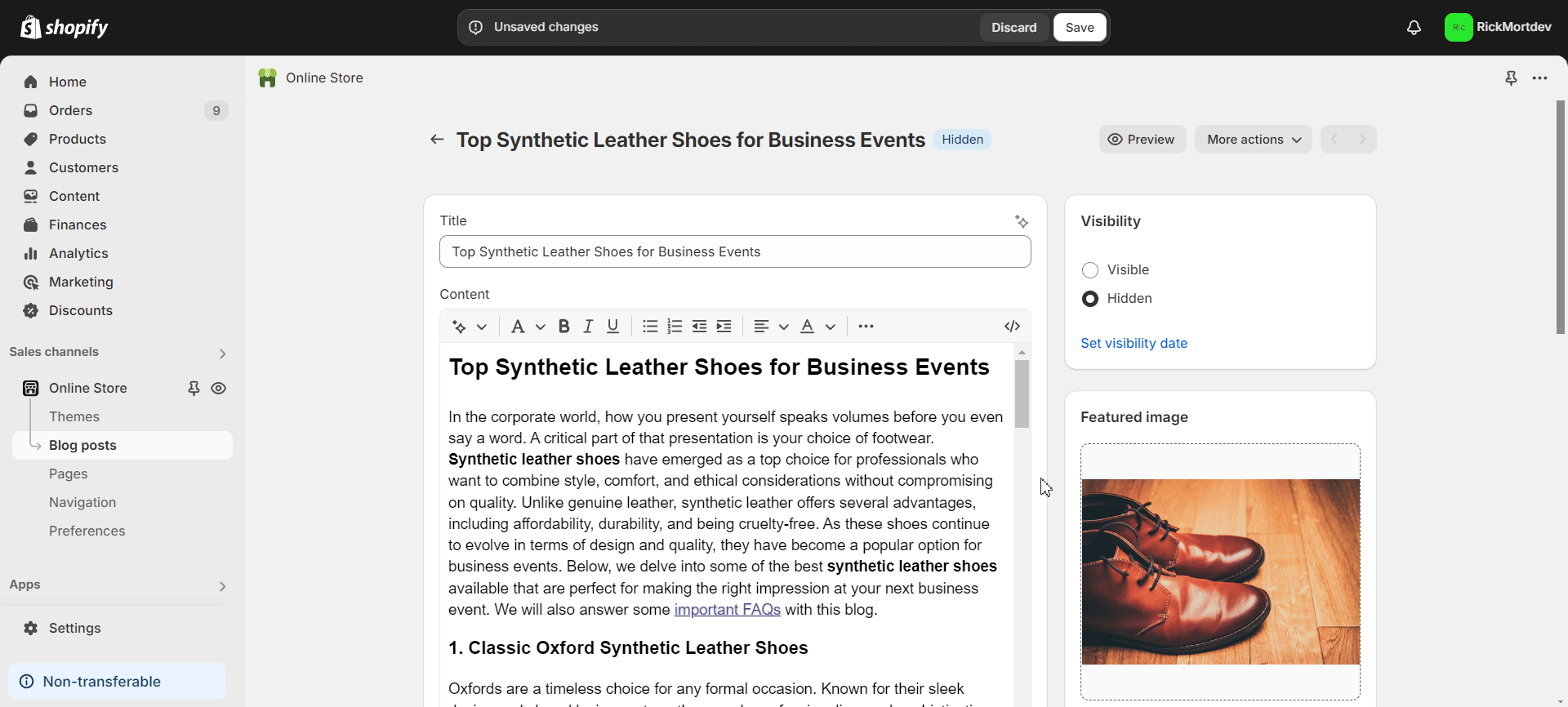
Add alt text to all images #
If you have multiple images in the blog post, ensure that the focus keyword is used in the alt text of all images. You have to do this when editing your blog post from Shopify dashboard as discussed before. Under the ‘Content’ section when editing a blog post, Double click on any image within the blog content. You will then be able to add the alt text in the ‘Image alt text’ field.
The images used in our blog post contain relevant alt text as shown in the image below.
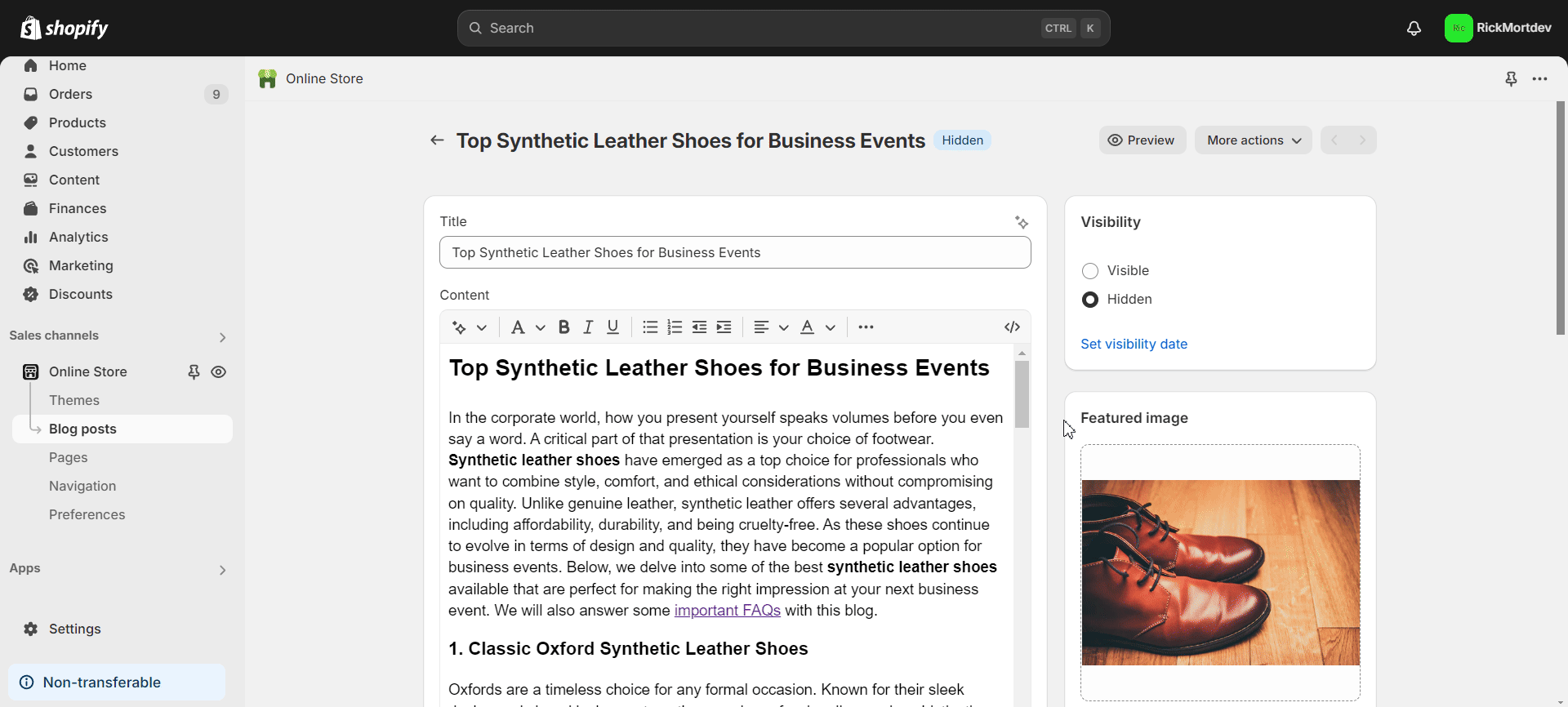
By following these steps, you can address every important SEO factor for the best possible optimization score for your blog post. If you need help to optimize your content for SEO with the power of AI, you can also use the StoreSEO AI Content Optimizer.
Once you are done with your blog post optimization and happy with the overall SEO Score, click on the ‘Save’ button.
This is how easily you can configure SEO for blog posts and pages on Shopify using StoreSEO. Need assistance? Feel free to reach out to our dedicated support team for any type of query.














